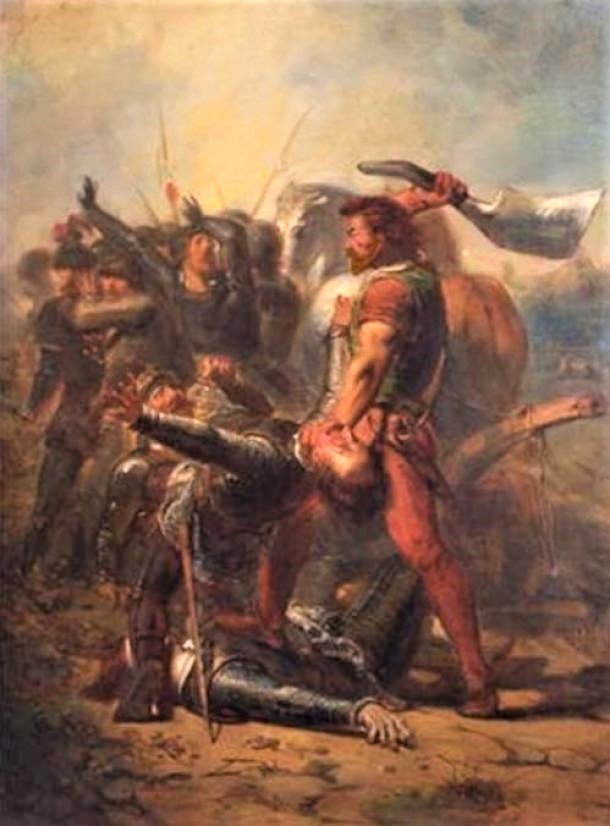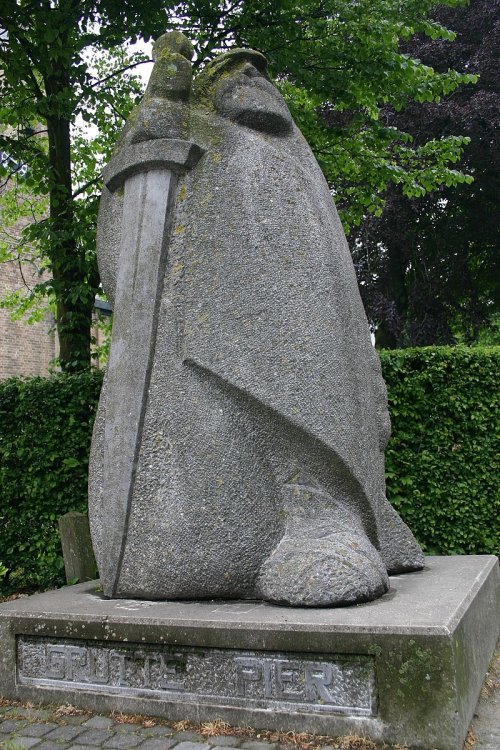Grutte Pier – Legendary Giant Frisian Freedom Fighter Who Sought Revenge
Ellen Lloyd - AncientPages.com - Known by his nickname, Grutte Pier was a man of extraordinary strength and size. His real name was Pier Gerlofs Donia, and he was born in 1480 in Kimswerd near Harlingen, Wonseradeel (modern Friesland, Netherlands).
"De dapperheid van Grote Pier" (The bravery of Grote Pier), anno 1516, Oil on canvas by Johannes Hinderikus Egenberger, (Arnhem 1822 – Utrecht 1897). Credit: Public Domain
He was a unique individual who should have been an ordinary farm boy, but when his village was plundered and his wife killed, he sought revenge on those who cost him pain and sorrow. To some, Grutte Pier was just a brutal rebel and pirate, but many regarded him as a legendary freedom fighter.
The Black Band Landsknechts - Feared European Mercenaries
On 29 January 1515, the Black Band landsknechts entered his village. The arrival of these German mercenaries made people tremble with fear.
During the 16th century, these Black Band landsknechts were the most feared soldiers on Europe's battlefields.
Like the Varangian Guard, they were military warriors hired to participate in an armed conflict.
In Grutte Pier's village, the Black Band landsknechts burned the church and Donia's estate. They murdered and plundered. Rintze Syrtsema, the wife of Grutte Pier, was raped and killed.
Image from an 1622, non-copyrighted historical book. It shows en:Pier Gerlofs Donia, or en:Grutte Pier, a en:Frisian en:freedom fighter, en:rebel and en:folk hero. It was made, over hundred years after the man depicted n it, died, so on ist historically accuracy might be some discussion (although it shows us an accurant painting of he man, he ain't whearing 16th centure clothes, but is dressed in 17th century clothing). Public Domain
Seeking revenge, Grutte Pier allied himself with Charles of Egmond, Duke of Gueldersand started a guerrilla war campaign against the House of Habsburg, also called the House of Austria. Grutte Pier blamed the Habsburg authorities for the events because they had employed the murderous regiment.
Pier Gerlofs Donia And His Arumer Zwarte Hoop Became Pirates
Grutte Pier received financial support from Charles II, Duke of Guelders, and his military campaign was successful.
The Arumer Zwarte Hoop's band consisted of peasant rebels who became dangerous pirates. Pier's pirates captured several English and Dutch ships using guerrilla tactics.
In Medemblik, the Arumer Zwarte Hoop also managed to siege two castles. It was an outstanding military achievement but at the cost of many victims. Grutte Pier and the Arumer Zwarte Hoop plundered Medemblik, killed many inhabitants, and some were taken as prisoners.
When Pier and his army stormed Nieuwburg and Middleburg Castle near Alkmaar, they plundered and set them on fire, leaving only ruins. Now he and the Arumer Zwarte Hoop were controlling a strategic military area.
In 1517, the Arumer Zwarte Hoop captured the town of Asperen, where they killed almost all inhabitants.
Pier's Forces Could Not Win Over The Habsburgs
Grutte Pier's freedom fight was undoubtedly successful, but he was also criticized for killing many innocent people.
Ultimately, the Habsburgs were too strong and couldn't be defeated.
Statue of Grutte Pier in his hometown of Kimswerd. The line of text on the foot of the statue reads in Frisian, "Grutte Pier." Credit: Public Domain - CC BY-SA 3.0
In 1519, Grutte Pier retired, and Lieutenant Wijerd Jelckama took command of the Arumer Zwarte Hoop. The peasant rebels fought for some years until they were finally captured and executed in 1523.
Grutte Pier died peacefully on 18 October 1520. Though he had no sons, he has many descendants through his daughter, Wobel. His tomb is located in the city of Sneek.
Grutte Pier And His Legendary Sword
At the Fries Museum in Leeuwarden, a giant sword is on display. It is said that it once belonged to Grutte Pier. These swords are known as Zweihänders and were primarily associated with Swiss or German mercenaries known as Landsknecht.
Grutte Pier's sword measures 2.13 meters (7 ft) in length and weighs about 6.6 kilograms (14.6 lb). It takes someone of extraordinary strength to use this kind of sword.
According to his Lieutenant Wijerd Jelckama, Grutte Pier could wield the sword and behead multiple people with it in a single blow. The Frisian pirate and freedom fighter was so strong that he could bend coins using his thumb, index, and middle finger. His giant helmet can be viewed in the town hall of Sneek.
Was Grutte Pier a giant? He was tall, but it's hard to classify him as a giant. Records state that his height was about 213 cm.
Long after his death, Grutte Pier became a legend giving rise to stories of other strong men in Germanic heroic literature.
Written by Ellen Lloyd – AncientPages.com
Updated on June 13, 2024
Copyright © AncientPages.com All rights reserved. This material may not be published, broadcast, rewritten, or redistributed in whole or part without the express written permission of AncientPages.com.
More From Ancient Pages
-
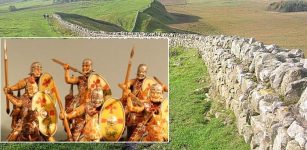 Hadrian’s Wall: North-West Frontier Of The Roman Empire For Nearly 300 Years
Featured Stories | Sep 1, 2020
Hadrian’s Wall: North-West Frontier Of The Roman Empire For Nearly 300 Years
Featured Stories | Sep 1, 2020 -
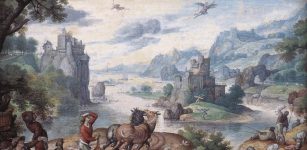 The Ancient ‘Flying Machines’ Of Icarus and Daedalus
Featured Stories | Aug 16, 2014
The Ancient ‘Flying Machines’ Of Icarus and Daedalus
Featured Stories | Aug 16, 2014 -
 Rare Gold Foils Found In Ancient Egyptian Tombs At Tel El-Deir In New Damietta
Archaeology | Jul 24, 2024
Rare Gold Foils Found In Ancient Egyptian Tombs At Tel El-Deir In New Damietta
Archaeology | Jul 24, 2024 -
 Explorer Discovered A Lost Underground World Beneath Big Sur In North America – But Why Cannot Anyone Else Find It Now?
Ancient Mysteries | Feb 12, 2019
Explorer Discovered A Lost Underground World Beneath Big Sur In North America – But Why Cannot Anyone Else Find It Now?
Ancient Mysteries | Feb 12, 2019 -
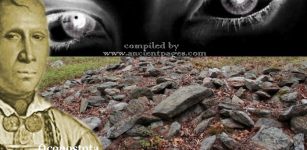 Mysterious Moon-Eyed People – Ancient Subterranean Race In Conflict With The Cherokee
Featured Stories | Dec 28, 2017
Mysterious Moon-Eyed People – Ancient Subterranean Race In Conflict With The Cherokee
Featured Stories | Dec 28, 2017 -
 Dura-Europos Roman Shield Created With Ancient Painting Techniques On Wood
Archaeology | Nov 9, 2015
Dura-Europos Roman Shield Created With Ancient Painting Techniques On Wood
Archaeology | Nov 9, 2015 -
 Who Were Or Are The Ninja – Those Ancient Spies And Mercenaries?
Featured Stories | Jul 3, 2018
Who Were Or Are The Ninja – Those Ancient Spies And Mercenaries?
Featured Stories | Jul 3, 2018 -
 4500-Year-Old Fingerprints Reveal Children Created Pottery Vessels In Ebla Kingdom
Archaeology | Oct 16, 2024
4500-Year-Old Fingerprints Reveal Children Created Pottery Vessels In Ebla Kingdom
Archaeology | Oct 16, 2024 -
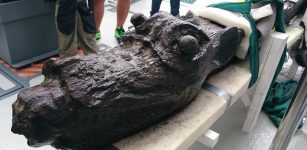 Mystery Of Gribshunden – Danish Royal Sunken Ship Sheds New Light On Psychological Warfare In The Middle Ages
Archaeology | Apr 14, 2017
Mystery Of Gribshunden – Danish Royal Sunken Ship Sheds New Light On Psychological Warfare In The Middle Ages
Archaeology | Apr 14, 2017 -
 Three Ingots Shed Light On The Mining Exploitation Of The Sierras de Córdoba Mountain Range
Archaeology | May 8, 2024
Three Ingots Shed Light On The Mining Exploitation Of The Sierras de Córdoba Mountain Range
Archaeology | May 8, 2024 -
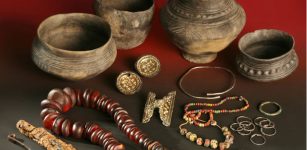 The Anglo-Saxon Migration: New Insights From Genetics
Archaeology | Sep 21, 2022
The Anglo-Saxon Migration: New Insights From Genetics
Archaeology | Sep 21, 2022 -
 Ranikot Fort: Gigantic Great Wall Of Pakistan Shows Greatness Of Indus Valley Civilization
Featured Stories | Mar 27, 2019
Ranikot Fort: Gigantic Great Wall Of Pakistan Shows Greatness Of Indus Valley Civilization
Featured Stories | Mar 27, 2019 -
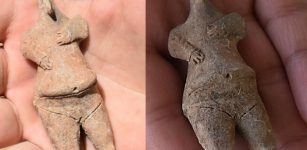 7,800-Year-Old Clay Female Figurine Unearthed In Ulucak Mound, Turkey’s Izmir
Archaeology | Aug 17, 2022
7,800-Year-Old Clay Female Figurine Unearthed In Ulucak Mound, Turkey’s Izmir
Archaeology | Aug 17, 2022 -
 Roman Empire’s Emerald Mines In The Egyptian Eastern Desert – New Evidence
Archaeology | Mar 2, 2022
Roman Empire’s Emerald Mines In The Egyptian Eastern Desert – New Evidence
Archaeology | Mar 2, 2022 -
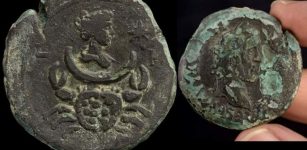 1,850-Year-Old Rare Bronze Coin, Depicting Roman Moon Goddess Luna – Unearthed
Archaeology | Aug 3, 2022
1,850-Year-Old Rare Bronze Coin, Depicting Roman Moon Goddess Luna – Unearthed
Archaeology | Aug 3, 2022 -
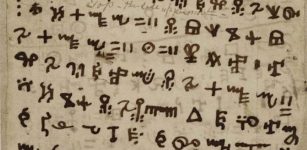 Vai Script – Rare African Manuscript Offers Clues Into How Writing Evolved
Archaeology | Jan 11, 2022
Vai Script – Rare African Manuscript Offers Clues Into How Writing Evolved
Archaeology | Jan 11, 2022 -
 On This Day In History: Anders Celsius, Swedish Astronomer And Mathematician Was Born – On Nov 27, 1701
News | Nov 26, 2016
On This Day In History: Anders Celsius, Swedish Astronomer And Mathematician Was Born – On Nov 27, 1701
News | Nov 26, 2016 -
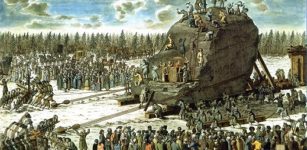 The Thunder Stone: World’s Largest Monolith Moved By Man
Ancient History Facts | Jun 14, 2018
The Thunder Stone: World’s Largest Monolith Moved By Man
Ancient History Facts | Jun 14, 2018 -
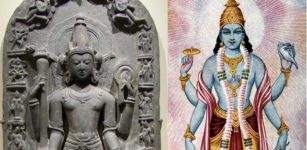 Vishnu: Supreme, Universal Hindu God Whose Avatars Reach Nations, Cultures And Races
Featured Stories | Jul 25, 2019
Vishnu: Supreme, Universal Hindu God Whose Avatars Reach Nations, Cultures And Races
Featured Stories | Jul 25, 2019 -
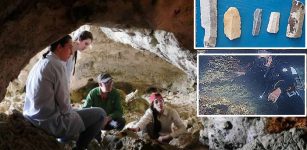 Early Expansion Of Homo sapiens: Underwater Caves Give New Clues About Sicily’s First Residents
Underwater Discoveries | Oct 15, 2024
Early Expansion Of Homo sapiens: Underwater Caves Give New Clues About Sicily’s First Residents
Underwater Discoveries | Oct 15, 2024

